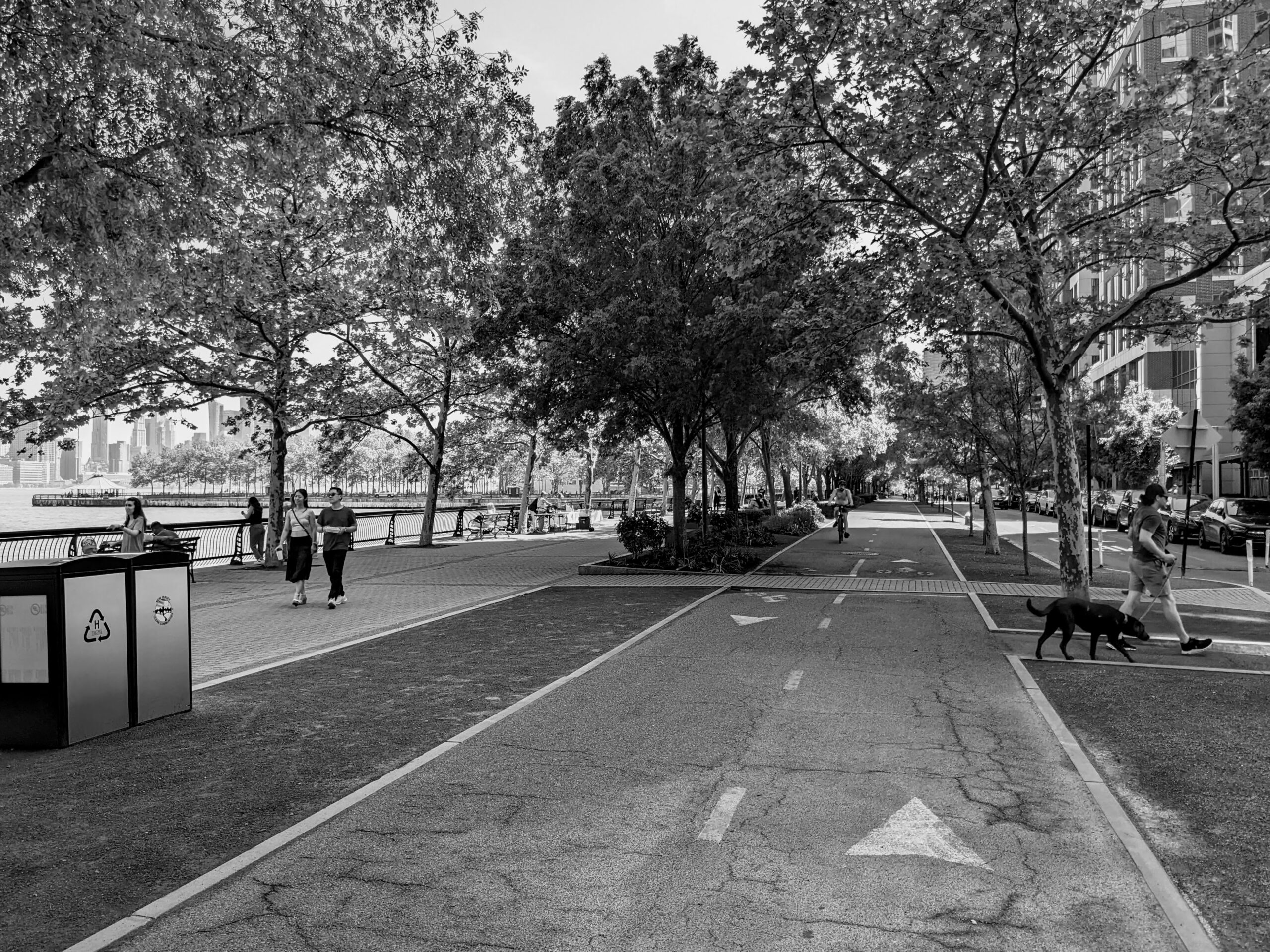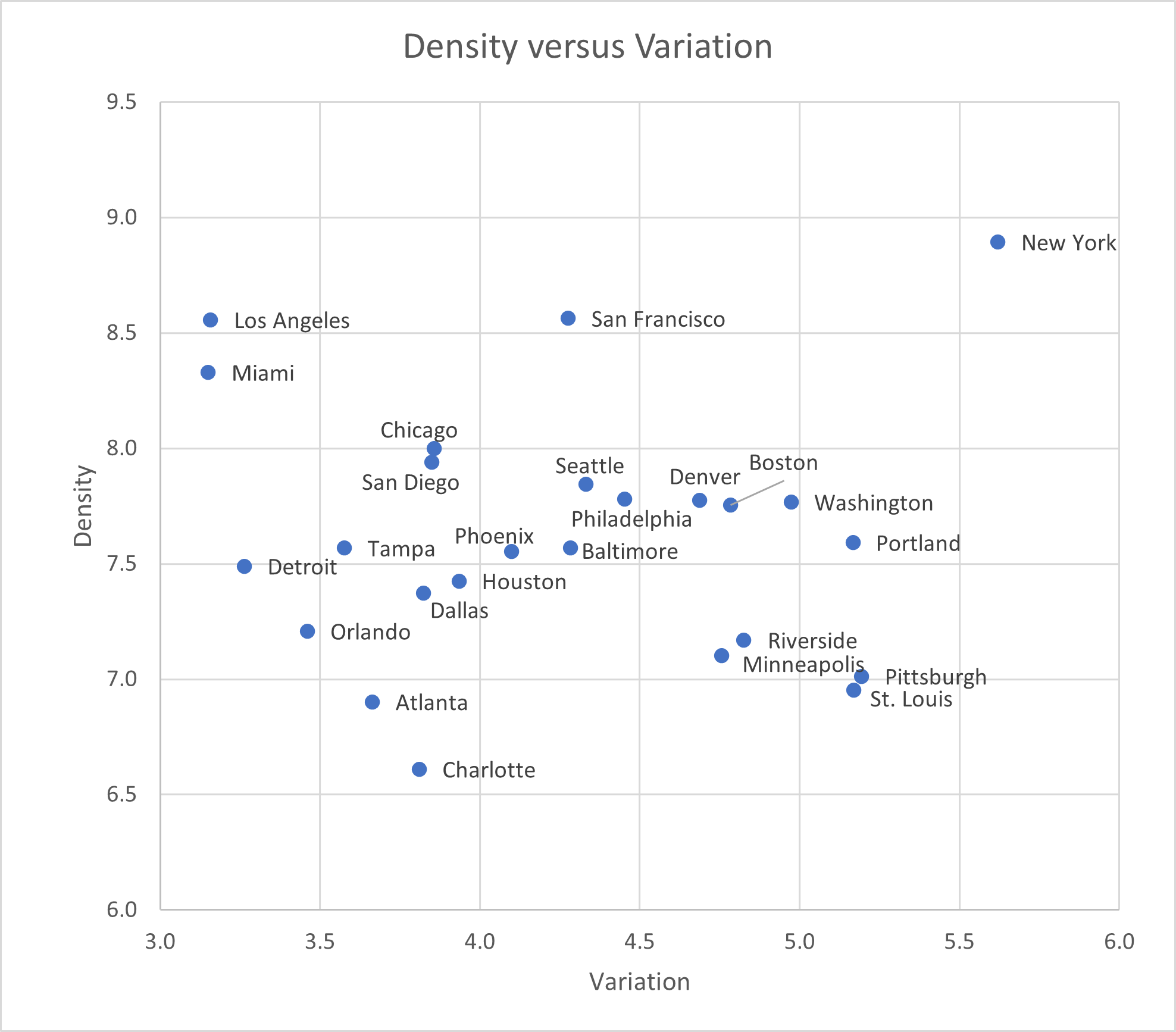Physical Address
304 North Cardinal St.
Dorchester Center, MA 02124
Physical Address
304 North Cardinal St.
Dorchester Center, MA 02124
Lydia Lo and Yonah Freemark have an interesting new paper ? EditSign on zoning in Louisville on the Urban Institute website. They point out that of the land zoned for single-family housing, 59 percent is zoned R4, requiring 9000-square-foot lots, which means no more than five houses per acre. From a transportation standpoint, this is not ideal. Even the most cursory Google search reveals that a neighborhood should have at least eight or ten units per acre to support minimal bus service. This is because if only a few people live near a bus stop, only a few people will ride the bus. So Louisville’s zoning generally prohibits density high enough for decent bus service. Similarly, from a housing supply standpoint, such zoning is not ideal either. Obviously, a development with 5 houses per acre contributes less to regional housing supply than one with 10 houses per acre. Much ink has been spilled over the evils of zoning places for nothing but single-family housing. But perhaps the density of housing is just as important as its form.

What's the best urban path in America? Vote on Twitter this month for nominees in the Urban Paths World Cup.

A quick data exercise shows that LA really is unique among big American metros, matched only by its East Coast twin, Miami.
One argument against bus lanes, bicycle lanes, congestion pricing, elimination of minimum parking requirements, or indeed almost any transportation improvement that gets in the way of high-speed automobile traffic is that such changes to the status quo might make sense in the Upper West Side, but that outer borough residents need cars. This argument is based on the assumption that almost anyplace outside Manhattan or brownstone Brooklyn is roughly akin to a suburb where all but the poorest households own cars and drive them everywhere. If this was true, outer borough car ownership rates and car commuting rates would be roughly akin to the rest of the United States. But in fact, even at the outer edges of Queens and Brooklyn, a large minority of people don’t own cars, and a large majority of people do not use them regularly. For example, let’s take Forest Hills in central Queens, where I lived for my first two years in New York City. In Forest Hills, about 40 percent of households own no car. (By contrast, in Central Islip, the impoverished suburb Long Island where I teach, about 9 percent of households are car-free- a percentage similar to the national average). Moreover, most of the car owners in Forest Hills do not drive to work. According to the U.S. Census Bureau’s American Community Survey (ACS), only 28 percent of the neighborhood’s workers drive or carpool to work. Admittedly, Forest Hills is one of the more transit-oriented outer borough neighborhoods. What about the city’s so-called transit deserts, where workers rely solely on buses? One such neighborhood, a short ride from Forest Hills, is Kew Gardens Hills. In this middle-class, heavily Orthodox Jewish neighborhood, about 28 percent of households are car-free- not a majority, but again high by American or suburban standards. And even […]
New York City is an epicenter of the global novel coronavirus pandemic. Through April 16, there were 1,458 confirmed cases per 100,000 residents in New York City. Always in the media eye, and larger than any other American city, New York City has become the symbol of the crisis, even as suburban counties nearby suffer higher rates of infection. In a paper dated April 13, 2020, Jeffrey E. Harris of M.I.T. claims that “New York City’s multitentacled subway system was a major disseminator – if not the principal transmission vehicle – of coronavirus infection during the initial takeoff of the massive epidemic.” Oddly, he does not go on to offer evidence in support of this claim in his paper. Conversely, as I will show, data show that local infections were negatively correlated with subway use, even when controlling for demographic data. Although this correlation study does not establish causation, it more reliably characterizes the spread of the virus than the intuitions and visual inspections that Harris relies on. Data In an ongoing crisis with a shortage of tests, all infection and mortality data come with a major asterisk: we do not fully know the extent of the data. Only when all-cause mortality data and more-extensive testing data are available can any conclusions be confirmed. This study, like Harris’ and others, is subject to potentially massive measurement error. Data from the American Community Survey (2018 5-year averages) show that commuting modes vary extensively across New York City. New York is broken into Community Districts (CDs), which generally correspond (on either a one-to-one or two-to-one basis) with Census Public Use Microdata Areas (PUMAs). These 55 areas contain between 110,000 and 241,000 people each. The most car-dependent PUMA (Staten Island CD3) has a car-commute share of 75%; the least car-dependent PUMA is Manhattan […]

In this interview I talk to Onésimo Flores, Founder of Jetty, a (sort-of) microtransit company from Mexico City. Marcos Schlickmann: Thank you for participating in this interview. Please introduce yourself and talk a little bit about how Jetty came to life and what is your idea behind this project. Onésimo Flores: I’m Onésimo Flores, the founder of Jetty. I have a PhD in urban planning from MIT and a master’s in public policy from Harvard. I graduated in Law from the Universidad Iberoamericana, Mexico. The idea of Jetty came about by contrasting a conflicting approach to regulation in public transportation in a place like Mexico. On one end of the spectrum, a you have a very tightly-regulated, low-quality, scarce public transport service, most of it operated by private, informal, artisanal, minibus operators, and on the other hand, ride-hailing apps, taxi apps, that had emerged not only Uber but several others, that enjoy a lot of regulatory leeway in terms of freedom to set their fares, to operate anywhere, to open the market to private individuals with spare time and spare vehicles. So, in that context, the hypothesis was that, in a way applications like Uber have made it possible to standardize a level of service: people can know what to expect, know that somebody will be held accountable if something goes wrong, know the basics of the trip, the fare and the rated quality of the driver. The level of information the passengers will get is standardized no matter who the supplier of the services is. So, the hypothesis in Jetty is that we can do something similar for collective transportation without relinquishing the economies of scale of using larger vehicles, but we do give the public access to the service improvements made possible by technology. MS: Talk a little […]

Many readers of this blog know that government subsidizes driving- not just through road spending, but also through land use regulations that make walking and transit use inconvenient and dangerous. Gregory Shill, a professor at the University of Iowa College of Law, has written an excellent new paper that goes even further. Of course, Shill discusses anti-pedestrian regulations such as density limits and minimum parking requirements. But he also discusses government practices that make automobile use far more dangerous and polluting than it has to be. For example, environmental regulations focus on tailpipe emissions, but ignore environmental harm caused by roadbuilding and the automobile manufacturing process. Vehicle safety regulations make cars safer, but American crashworthiness regulations do not consider the safety of pedestrians in automobile/pedestrian crashes. Speeding laws allow very high speeds and are rarely enforced. If you don’t want to read the 100-page article, a more detailed discussion is at Streetsblog.

With the Democrats scrambling to come up with a legislative agenda after their November takeover of the House of Representatives, an old idea is making a comeback: a “Green New Deal.” Once the flagship issue of the Green Party, an environmental stimulus package is now a cause de celebre among the Democratic Party’s progressive wing. While it looks like the party leadership isn’t too receptive to the idea, newly-elected Representative Alexandria Ocasio-Cortez has spearheaded legislation designed to create a “Select Committee for a Green New Deal.” The mandate of the proposed committee is ambitious, possibly to a fault. At times utopian in flavor, the committee would pursue everything from reducing greenhouse gas emissions to labor law enforcement and universal health care. A recent plan from the progressive think tank Data for Progress is more disciplined, remaining focused on environmental issues, with clearer numerical targets for transitioning to renewable energy and reducing greenhouse gas emissions. Yet in all the talk about a Green New Deal, there’s a conspicuous omission that could fatally undermine efforts to reduce greenhouse gas emissions: little to no focus is placed on the way we plan urban land use. This is especially strange considering the outsized role that the way we live and travel plays in raising or lowering greenhouse gas emissions. According to the Environmental Protection Agency (EPA), transportation and electricity account for more than half of the US’ greenhouse gas emissions. As David Owen points out in his book “Green Metropolis,” city dwellers drive less, consume less electricity, and throw out less trash than their rural and suburban peers. This means that if proponents of the Green New Deal are serious about reducing carbon emissions, they will have to help more people move to cities. One possible reason for this oversight is that urban planning […]
This book is an attack on current city planning and rebuilding. This is how Jane Jacobs opened her 1961 classic “The Death and Life of Great American Cities”. It wouldn’t be an inappropriate opener for Alain Bertaud’s upcoming “Order Without Design”. While Jacobs was an observer of how cities work and a contributor to new concepts in urban economics, Bertaud goes a step further. His book brings economic logic and quantitative analysis to guide urban planning decision-making, colored by a hands-on, 55-year career as a global urban planner. His conclusion? The urban planning practice is oblivious to the economic effects of their decisions, and eventually creates unintended consequences to urban development. His goal with this book is to bring economics as an important tool to the urban planning profession, and to bring economists closer to the practical challenge of working with cities. Maybe you have not heard about Alain Bertaud before: at the time I am writing this article, he has only a few articles published online, no Wikipedia page or Twitter account, and some lectures on YouTube – and nothing close to a TED talk. The reason is that instead of working on becoming a public figure, Bertaud was actually doing work on the ground, helping cities in all continents tackle their urban development problems. His tremendous experience makes this book that delves into urban economics surprisingly exhilarating. As an example, Bertaud shows a 1970 photo from when he was tracing new streets in Yemen using a Land Rover and the help of two local assistants who look 12 years old at most, a depiction of a real-life Indiana Jones of urban planning. In this book, mainstream urban planning “buzzwords” such as Transit-Oriented Development, Inclusionary Zoning, Smart Growth and Urban Growth Boundaries are challenged with economic analysis, grounded on […]
Some urbanists have become skeptical about the future of autonomous vehicles even as unstaffed, autonomous taxis are now serving customers in Phoenix and Japan. Others worry that AVs, if they are ever deployed widely, will make cities worse. Angie Schmitt posits that allowing AVs in cities without implementing deliberate pro-urban policies first will exacerbate the problems of cars in urban areas. However, cars themselves aren’t to blame for the problems they’ve caused in cities. Policymakers created rules that dedicated public space to cars and prioritized ease of driving over other important goals. Urbanists should be optimistic about the arrival of AVs because urbanist policy goals will be more politically tenable when humans are not behind the wheel. To avoid repeating mistakes of the past, policymakers should create rules that neither subsidize AVs nor give them carte blanche over government-owned rights-of-way. Multiple writers have pointed out that city policymakers should actively be designing policy for the driverless future, but few have spelled out concrete plans for successful driverless policy in cities. Here are three policies that urban policymakers should begin experimenting with right away in anticipation of AVs. Price Roadways Perhaps the biggest concern AVs present for urbanists is that they may increase demand for sprawl. AVs may drastically reduce highway commute times over a given distance through platooning, and if people find their trips in AVs to be time well-spent, when they can work, relax, or sleep, they may be willing to accept even more time-consuming commutes than they do today. As the burden of commuting decreases, they reason, people will travel farther to work. However, the looming increase in sprawl would be due in large part to subsidized roads, not AVs themselves. If riders would have to fully internalize the cost of using road space, they would think twice […]